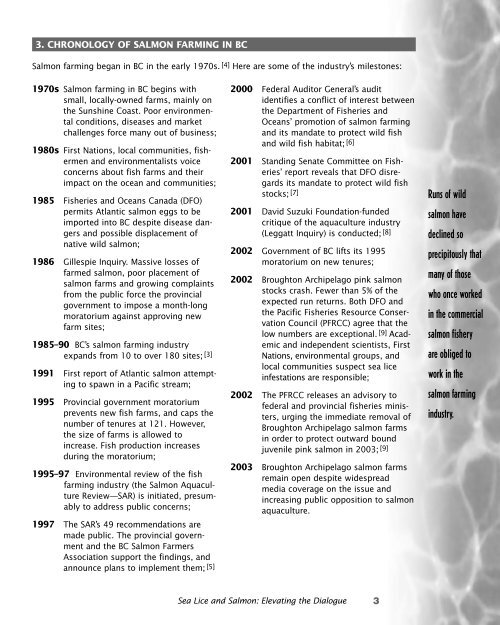Sea Lice AND Salmon - Farmed And Dangerous
Sea Lice AND Salmon - Farmed And Dangerous
Sea Lice AND Salmon - Farmed And Dangerous
You also want an ePaper? Increase the reach of your titles
YUMPU automatically turns print PDFs into web optimized ePapers that Google loves.
3. CHRONOLOGY OF SALMON FARMING IN BC<strong>Salmon</strong> farming began in BC in the early 1970s. [4] Here are some of the industry’s milestones:1970s <strong>Salmon</strong> farming in BC begins withsmall, locally-owned farms, mainly onthe Sunshine Coast. Poor environmentalconditions, diseases and marketchallenges force many out of business;1980s First Nations, local communities, fishermenand environmentalists voiceconcerns about fish farms and theirimpact on the ocean and communities;1985 Fisheries and Oceans Canada (DFO)permits Atlantic salmon eggs to beimported into BC despite disease dangersand possible displacement ofnative wild salmon;1986 Gillespie Inquiry. Massive losses offarmed salmon, poor placement ofsalmon farms and growing complaintsfrom the public force the provincialgovernment to impose a month-longmoratorium against approving newfarm sites;1985–90 BC’s salmon farming industryexpands from 10 to over 180 sites; [3]1991 First report of Atlantic salmon attemptingto spawn in a Pacific stream;1995 Provincial government moratoriumprevents new fish farms, and caps thenumber of tenures at 121. However,the size of farms is allowed toincrease. Fish production increasesduring the moratorium;1995–97 Environmental review of the fishfarming industry (the <strong>Salmon</strong> AquacultureReview—SAR) is initiated, presumablyto address public concerns;1997 The SAR’s 49 recommendations aremade public. The provincial governmentand the BC <strong>Salmon</strong> FarmersAssociation support the findings, andannounce plans to implement them; [5]2000 Federal Auditor General’s auditidentifies a conflict of interest betweenthe Department of Fisheries andOceans’ promotion of salmon farmingand its mandate to protect wild fishand wild fish habitat; [6]2001 Standing Senate Committee on Fisheries’report reveals that DFO disregardsits mandate to protect wild fishstocks; [7]2001 David Suzuki Foundation-fundedcritique of the aquaculture industry(Leggatt Inquiry) is conducted; [8]2002 Government of BC lifts its 1995moratorium on new tenures;2002 Broughton Archipelago pink salmonstocks crash. Fewer than 5% of theexpected run returns. Both DFO andthe Pacific Fisheries Resource ConservationCouncil (PFRCC) agree that thelow numbers are exceptional.[9] Academicand independent scientists, FirstNations, environmental groups, andlocal communities suspect sea liceinfestations are responsible;2002 The PFRCC releases an advisory tofederal and provincial fisheries ministers,urging the immediate removal ofBroughton Archipelago salmon farmsin order to protect outward boundjuvenile pink salmon in 2003; [9]2003 Broughton Archipelago salmon farmsremain open despite widespreadmedia coverage on the issue andincreasing public opposition to salmonaquaculture.Runs of wildsalmon havedeclined soprecipitously thatmany of thosewho once workedin the commercialsalmon fisheryare obliged towork in thesalmon farmingindustry.<strong>Sea</strong> <strong>Lice</strong> and <strong>Salmon</strong>: Elevating the Dialogue3
















